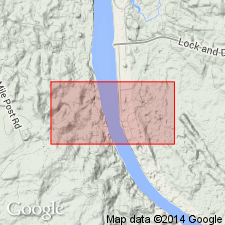
- Usage in publication:
-
- Lisbon horizon
- Modifications:
-
- Biostratigraphic dating
- AAPG geologic province:
-
- Mid-Gulf Coast basin
Summary:
Pg. 44-60. Lisbon horizon in [Claiborne group]. Divided the Claiborne into (descending) Claiborne sand, calcareous sand bed, and Lisbon horizon, the latter overlying the Buhrstone (excluded from the Claiborne).
Source: US geologic names lexicon (USGS Bull. 896, p. 1189-1190).
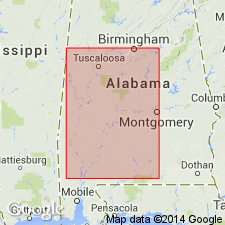
- Usage in publication:
-
- Lisbon beds*
- Modifications:
-
- Principal reference
- AAPG geologic province:
-
- Mid-Gulf Coast basin
Summary:
Pg. 30. Lisbon beds. Gave a detailed section of Lisbon Bluff, on Alabama River, and explained relations of the beds in that bluff (which constitute basal beds of their Claiborne --from which they exclude the †Buhrstone) to the beds in Claiborne bluff, farther down the river. The two lowermost beds in Claiborne bluff are stated to be same as two uppermost beds in Lisbon bluff. In explanation of this section the term Libson beds is casually used once.
Source: US geologic names lexicon (USGS Bull. 896, p. 1189-1190).
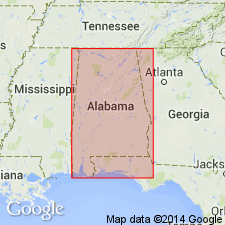
- Usage in publication:
-
- Lisbon bed
- Modifications:
-
- Areal extent
- Dominant lithology:
-
- Sand
- Clay
- AAPG geologic province:
-
- Mid-Gulf Coast basin
Summary:
Pg. 598-604. Lisbon bed in Claiborne series. Claiborne series is divided into (descending): SCUTELLA bed, 25 to 30 feet; Ferruginous sands or Claiborne proper; OSTREA SELLAEFORMIS bed, 75 feet of gray calcareous sand; and Lisbon bed, 45 feet. The latter differs from above mainly in fossils, and appears to be confined to region drained by Alabama and Conecuh Rivers. It rests on the Buhrstone [excluded from the Claiborne].
Source: US geologic names lexicon (USGS Bull. 896, p. 1189-1190).
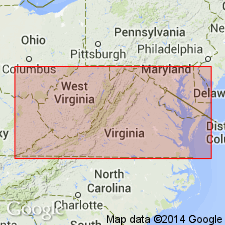
- Usage in publication:
-
- Lisbon beds (substage)
- Modifications:
-
- Revised
- AAPG geologic province:
-
- Mid-Gulf Coast basin
Summary:
Pg. 303-304. Lisbon beds (substage). Lower Claiborne stage is divided into (descending) OSTREA SELLAEFORMIS beds (substage), Lisbon beds (substage), and Buhrstone (substage). [The rocks are not described.]
Source: US geologic names lexicon (USGS Bull. 896, p. 1189-1190).

- Usage in publication:
-
- Lisbon formation*
- Modifications:
-
- Overview
- AAPG geologic province:
-
- Mid-Gulf Coast basin
Summary:
Lisbon formation of Claiborne group. Age is middle Eocene. Recognized in southwestern Alabama and Mississippi.
In present (ca. 1938) usage of names the Claiborne group in Alabama is divided into (descending): Gosport sand (highly glauconitic sands in which OSTREA SELLAEFORMIS zone is included); Lisbon formation; and Tallahatta formation (†Buhrstone). The Lisbon formation, according to E.A. Smith (Alabama Geol. Survey Underground water resources Alabama, 1907), consists of 115 feet of calcareous, clayey sands and sandy clays. In Mississippi the Lisbon consists of fossiliferous calcareous sands, clay, and greensand underlying the Yegua formation and overlying the Tallahatta, and is now divided into an upper (unnamed) member 100 to 120 feet thick, underlain by Kosciusko sandstone member, 25 to 400 feet thick, succeeded below by Winona sand member, 45 to 350 feet thick. It has not been subdivided in Alabama. It is middle formation of Claiborne group, and of marine origin.
Named from exposures in Lisbon Bluff, on Alabama River, in Clarke Co., AL.
Source: US geologic names lexicon (USGS Bull. 896, p. 1189-1190).
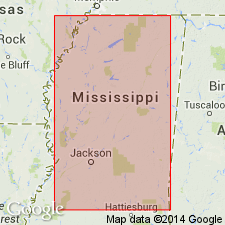
- Usage in publication:
-
- Lisbon formation
- Modifications:
-
- Revised
- AAPG geologic province:
-
- Mid-Gulf Coast basin
Summary:
Pg. 122. Lisbon formation in Mississippi includes Kosciusko and Chickasawhay (new) members. (Chickasawhay as used here includes Wautubbee marl.) [Age is middle Eocene.]
Source: US geologic names lexicon (USGS Bull. 1200, p. 2181-2182).
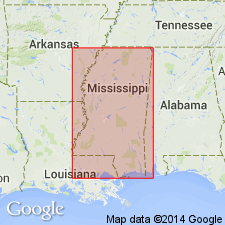
- Usage in publication:
-
- Lisbon formation
- Modifications:
-
- Revised
- AAPG geologic province:
-
- Mid-Gulf Coast basin
Summary:
[Chart originally published in Mississippi Geol. Soc. Gdbk. 1, Feb. 1940; revised chart published in AAPG Bull. (submitted Oct. 1940).] Lisbon formation of Claiborne group. Includes (ascending) Winona sand, Zilpha clay (new), Kosciusko sand, and Wautubbee marl members. Overlies Tallahatta formation; underlies Yegua formation (all of Claiborne). [Age is middle Eocene.]
Source: Publication; US geologic names lexicon (USGS Bull. 1200, p. 2181-2182).
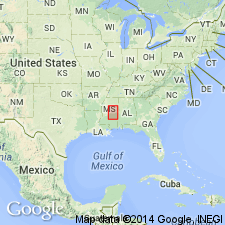
- Usage in publication:
-
- Lisbon formation
- Modifications:
-
- Not used
- AAPG geologic province:
-
- Mid-Gulf Coast basin
Thomas, E.P., 1942, The Claiborne: Mississippi Geological Survey Bulletin, no. 48, 96 p.
Summary:
Pg. 29, 40, 48. Winona greensand, Kosciusko, and Wautubbee are treated as formations and not part of Lisbon formation. [Age is middle Eocene.]
Source: US geologic names lexicon (USGS Bull. 1200, p. 2181-2182).
- Usage in publication:
-
- Lisbon formation
- Modifications:
-
- Areal extent
- AAPG geologic province:
-
- Mid-Gulf Coast basin
GNC Staff, 1944, [U.S. Geologic Names Committee remark on the Lisbon formation]: U.S. Geological Survey, unpublished Geologic Names Committee note
Summary:
Term Lisbon formation will not be used on the Geologic Map of Mississippi (Monroe and others). By raising the Winona and the Kosciusko to the rank of formation and reinstating the Wautubbee as a formation, the term Lisbon is restricted from use in MS (Committee meeting 4/20/1944). Kosciusko replaced by name Sparta sand. Wautubbee replaced by name Cook Mountain. Lisbon is retained for use in AL (Committee meeting 5/2/1944).
Source: GNU records (USGS DDS-6; Reston GNULEX).
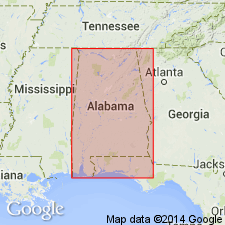
- Usage in publication:
-
- Lisbon formation*
- Modifications:
-
- Areal extent
- AAPG geologic province:
-
- Mid-Gulf Coast basin
Summary:
Pg. 22. Lisbon formation in Alabama is equivalent of Winona sand, Zilpha clay, Sparta sand (Kosciusko), and Cook Mountain formation (Wautubbee) combined. [Age is middle Eocene.]
Source: US geologic names lexicon (USGS Bull. 1200, p. 2181-2182).
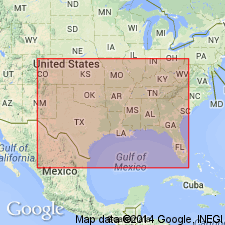
- Usage in publication:
-
- Lisbon formation*
- Modifications:
-
- Areal extent
- AAPG geologic province:
-
- South Georgia sedimentary province
Summary:
Chart of outcropping Tertiary formations of eastern Gulf region shows Lisbon formation present in Georgia.
Source: US geologic names lexicon (USGS Bull. 1200, p. 2181-2182).
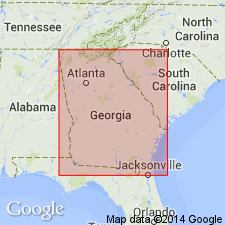
- Usage in publication:
-
- Lisbon Formation
- Modifications:
-
- Revised
- AAPG geologic province:
-
- South Georgia sedimentary province
Summary:
Lisbon Formation subdivided in GA into McBean Member (top) and Blue Bluff Member. Underlies Barnwell or Ocala Groups. Assigned to Claiborne Group in western Coastal Plain.
Source: GNU records (USGS DDS-6; Reston GNULEX).
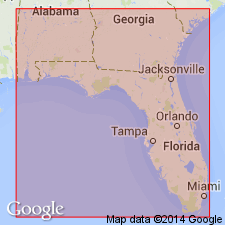
- Usage in publication:
-
- Lisbon Formation*
- Modifications:
-
- Areal extent
- AAPG geologic province:
-
- Mid-Gulf Coast basin
Summary:
Middle Eocene Lisbon Formation is geographically extended from western AL to FL panhandle in subsurface. Overlies Tallahatta Formation; underlies Moodys Branch Formation.
Source: GNU records (USGS DDS-6; Reston GNULEX).

- Usage in publication:
-
- Lisbon Formation
- Modifications:
-
- Overview
- AAPG geologic province:
-
- Mid-Gulf Coast basin
Summary:
Lisbon Formation of Claiborne Group in AL is described as glauconitic, calcareous, fossiliferous sand and sandy clay. It is divisible into three units: "lower" Lisbon is a coarse-grained glauconitic, highly fossiliferous sand; "middle" Lisbon is mostly carbonaceous sand and carbonaceous silty clay; "upper" Lisbon is the thickest (75 ft) unit consisting of glauconitic, calcareous clayey sand, sandy clay and calcareous sand, all containing fossils. Formation is present in the Coastal Plain of south AL. The thickness of the formation from west to east ranges from 165 to 75 ft. Age is Eocene (Lutetian-Bartonian).
Source: GNU records (USGS DDS-6; Reston GNULEX).
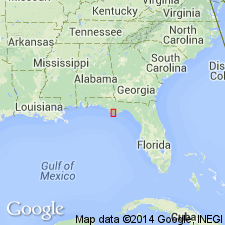
- Usage in publication:
-
- Lisbon Formation
- Modifications:
-
- Overview
- AAPG geologic province:
-
- South Georgia sedimentary province
Summary:
According to author, differentiation of middle Eocene Tallahatta and Lisbon Formations in Gulf Co. is not possible using lithologic criteria and so the two units are grouped into Tallahatta/Lisbon Formations undifferentiated. Because Gulf Co. lies in a transitional area of the FL panhandle over the axis of the Apalachicola Embayment, there may be constituents characteristic of the carbonate Avon Park Formation, the eastern facies equivalent of the Tallahatta and Lisbon.
Source: GNU records (USGS DDS-6; Reston GNULEX).
For more information, please contact Nancy Stamm, Geologic Names Committee Secretary.
Asterisk (*) indicates published by U.S. Geological Survey authors.
"No current usage" (†) implies that a name has been abandoned or has fallen into disuse. Former usage and, if known, replacement name given in parentheses ( ).
Slash (/) indicates name conflicts with nomenclatural guidelines (CSN, 1933; ACSN, 1961, 1970; NACSN, 1983, 2005, 2021). May be explained within brackets ([ ]).

